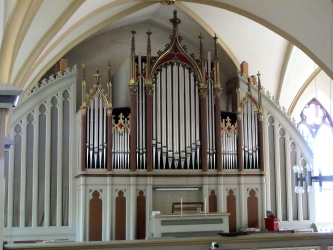Organ Art Media 1677 Michel Carboni Organ Santuario Nostra Signora della Caravina Valsolda ComoI taly
Contact us for a price
Description
The organ is located in a middle-sized baroque church in Valsolda/Italy near Lugano. Due to large amount of marbled walls, the architecture has surprising acoustical properties with a rich and long reverberation. The organ was built by a the Ticinese organ manufacturer Michele Carboni in 1675 to 1677. The original room ambience with a reverberation time of about 4 seconds and the original tracker noises are captured precisely within this project.
This instrument is a typical historical Italian organ, which normally has one manual and a small pedalboard compass, serving only as a bass fundament. Italian historical organs normally serve especially for liturgical purposes and accompaniment of the choir, thus being not a special solistic instrument . There are no combined stops, such as mixtures with a common repetition scheme found in other European organs. The overtone stops are realized as separate Principal ranks (very often up to 1/8 ') which only repeat in high keys, such having the ability to built very special tonal structures and mixture-like sounds. A typical stop is the "Voce umana", which is not a reed stop, but a special slightly detuned pipe rank for chorus like effects. Italian organs are based on sonouros and warm Principal ranks and additionally have high and powerful overtone ranks for harpsichord like sounds. The organ has relations to Antegnati sound characteristics, having bright and rich overtones (compare the Venetian Callido 18th type).
Another special feature is the "Terzo mano" (third hand), an intra-manual octave coupler, which leads to an extraordinary full sound, but which was probably first added in 18th or 19th century and shouldn't normally be used for 17th century music.
Unfortunately the organ was set to equal temperament in the 19th century. To get back its 17th century sound, we decided to set back the organ to mean tone temperament. The organ now can again be heard in its probably most authentic sound.
The Carboni organ is in a very good shape due to a lot of pilgrim donations for the Santuary.
The organ was recorded in September 2003 with 44 kHz, 16 bit, multi-channel for Hauptwerk 1
Organ temperament:
Equal temperament at a1=440 Hz unfortunately probably sice 19th century
The virtual organ was therefore set back to mean tone temperament!
Manual compass:
F, G, A - g2, a2
Pedal compass:
C - d
c - d repeated from lower octave
Pedal fixed coupled to manual
Note:
The Carboni organ sound is based on Principale 16' (historically named: Principale 12', beginning at F)
but the F, G, A keys are not present on modern organ compasses. Therefore organist Fabio Mancini defined a historically renamed and reorganized version (stop names based on Principale 12', voce umana based on P12) playable in modern organ manual compass (beginning at C)
The Terzo Mano octave coupler was probably added in 18th or 19th century
Actual stop list (stop names based on Principale 8', voce umana based on P8):
Main
Mnemo
Modern
1
Principale 16' (c)
P16
16'
2
Principale 8 '
P8
8'
3
Ottava 4'
O4
4'
4
Duodecima
XII
2 2/3'
5
Quintadecima
XV
2'
6
Decimanona
XIX
1 1/3'
7
Vigesimaseconda
XXII
1'
8
Vigesimasesta
XXVI
2/3'
9
Vigesimanona
XXIX
1/2'
10
Flauto 8'
FlVIII
11
Flauto in XII'
FlXII
5 1/3'
12
Voce umana (f#1)
Voc
Chorus
13
Contrabassi 16'
Cb16
Pedal
14
Terzo mano
Tm
Octave Coupler
Historically renamed and reorganized stop list by Fabio Mancini (stop names based on Principale 12', voce umana based on Principale 12'):
Main
Mnemo
Modern
1
Principale 12' (C)
P12
8'
2
Ottava 6 '
O6
4'
3
Quintadecima
XV
2'
4
Decimanona
XIX
1 1/3'
5
Vigesimaseconda
XXII
1'
6
Vigesimasesta
XXVI
2/3'
7
Vigesimanona
XXIX
1/2'
8
Trigesimaterza
XXXIII
1/3'
9
Trigesimasesta
XXXVI
1/4'
10
Flauto in VIII
FlVIII
4'
11
Flauto in XII'
FlXII
2 2/3'
12
Voce umana (f#1)
Voc
Chorus
13
Contrabassi 16'
Cb16
Pedal
14
Terzo mano
Tm
Octave Coupler
Available organ definition files:
Carboni-P12-Meantone:
Modern adapted manual compass (C- g2, a2).
NOTE: Historically renamed stops, Voce umana compass shifted one octave (adapted to most ancient Italian organ music). Reduced manual compass beginning with Principale 12‘ at C (usual modern organ console compass), thus F-B are not playable!!
Carboni-P12b-Meantone:
Original manual compass (F, G, A - g2, a2).
NOTE: Complete original manual compass shifted one octave to be able to play all notes on modern organ consoles (F - a2), but one octave higher than usual!
Do you want to see this product in our showroom?
Simply fill out this form and we will contact you to arrange an appointment!






